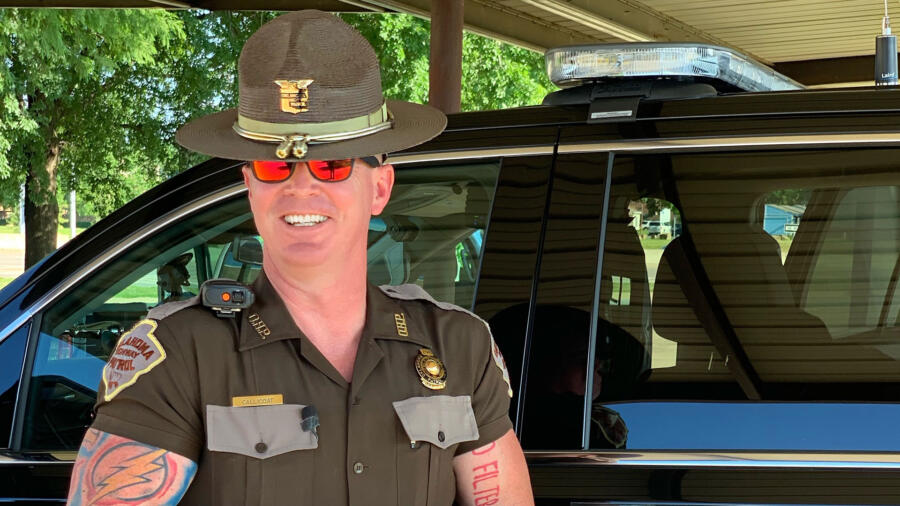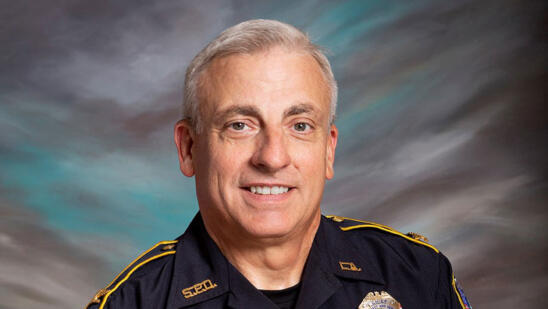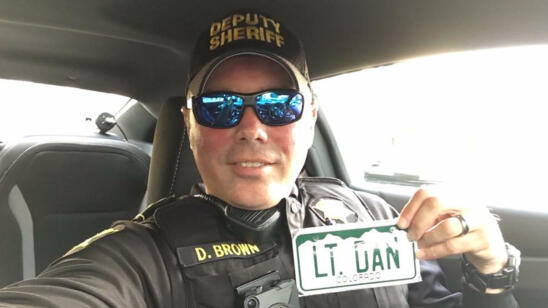Ten-year-old Russell Callicoat was a kid with a dream—to grow up to serve as an Oklahoma Highway Patrol Trooper. Now, more than 30 years later, he spoke with A&E True Crime about the significance of this dream becoming a reality.
How did you know law enforcement was the right path for you?
When I was around 10 years old, we lived in a little house in the Oklahoma City area. Down this one road lived an Oklahoma state trooper, and every day I would run out and meet him and flag him down. I probably bugged him [laughs]. He would let me climb into his car, turn up his loudspeaker, turn his lights on—the whole works. From that point on until I finally became a state trooper, that’s all I wanted to be.
Are you in touch with him now?
I actually do not know who that trooper is. I’ve tried to find him, and still to this day, we’re trying to locate who that trooper was. I would like to thank him for instilling in me the values, integrity and everything the highway patrol is. He was a perfect example of what I wanted to do with my life.
What would you be doing if you hadn’t become a trooper?
I think my next career or life choice would be the United States military and the branch I would choose would be the United States Marine Corps. My dad was a Vietnam veteran and he served in the Marine Corps, so I’d want to follow in his footsteps.
What has been your most memorable on-the-job moment?
I’ve had a lot of smaller, good moments, but unfortunately, the most memorable for me is when I was on a traffic stop on the interstate, near Tulsa. I was arresting a drunk driver, and I then got struck by another drunk driver—which totaled my car, and injured me up pretty good.
It put into perspective that that’s why I do what I do. I would rather somebody hit me than hit the average citizen out there on the road, because that’s what my job is: to put myself in between that danger and the average citizen.
Is there anything your department does to connect with the community?
Definitely. That goes back to why I became a state trooper. Friday night football is really big in Oklahoma, and in my hometown on a Friday night you would always see a state trooper car pulled up right by the end zone, and the trooper would be sitting on his hood. That was a way for the community to meet their local state troopers, get to know them.
It’s the same today. We want our communities to see that we’re part of the community: we’re dads, we’re moms. We do so many safety programs, and I talk to high schools, to instill in these kids to make good decisions. We do fairs and media events, and pretty much anything with the public where we can let these children and adults know we’re part of this community.
Your department changed its tattoo policy so that troopers no longer have to cover them up. Was that something you were working on?
I was not working on a policy change. With the [former] policy, we had to cover up our tattoos. Then, not too long ago, the tattoo policy came up for review and they changed [it so] we still have restrictions, but the tattoos can be visible.
It’s been great for me, obviously, because now I can show my tattoos—I don’t have to cover them up! And I think it opens up our applicant pool because a ton of people [who] have tattoos [might not have tried to become troopers].
It’s definitely a good conversation piece.
When I make contact with someone on a traffic stop, whether I’m arresting the person, or helping a motorist on the side of the road, immediately, [the tattoos] ease that gap, [showing] that we’re your neighbors, we live in the community. We have tattoos, you have tattoos. It eases a lot of tension. I can say it’s been a complete positive in my interaction with people.
When the Oklahoma Highway Patrol pulls a car over, the troopers have the driver sit in the front passenger seat of the trooper’s car. That has sparked some conversation on social media, including from other law-enforcement officers. Can you talk about that?
It’s not a policy. It’s a training that’s instilled in every Oklahoma highway patrolman. When we transport people to jail, we transport them in the front seat. We can have more control over the subject; we can see what the subject’s doing. We’re not [putting] them in the backseat, [like we would] in a caged police car. In my experience being with highway patrol, you have more advantage having them in the front.
No [Oklahoma] highway trooper has a cage in the car. The only cages in our car are for our K9 units—not for transporting subjects. If you put somebody in the backseat, they’re behind you, and if you don’t have a barrier there, you’re just opening yourself up for danger. Obviously if we NEED a transport cage for a violent suspect, or something like that, we always have our local police departments and sheriffs’ departments, which do have that equipment.
What’s the biggest positive you see about ‘Live PD’—as a show in general and as a result of your being part of it?
I think the show lets the people get to know their officers, deputies and troopers. [It helps the public understand that] we live in the community, we’re coaches, we go out to dinner with our families—it bridges that gap.
Related Features:
‘Live PD Officer Jill Marshall on Going Undercover and Her Approach to Work
Senior Deputy Garo Brown on That ‘Licensed Crack’ Moment
Officer Charlie Kingery on Lessons from ‘Live PD’ and Being Himself
From Police Work to Daddy Time: An Interview with Sgt. John Curley of ‘Live PD’


